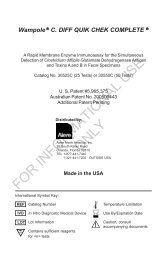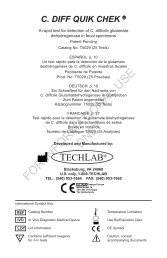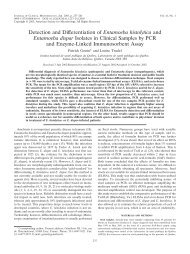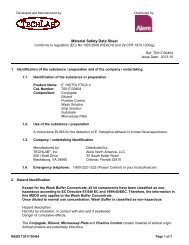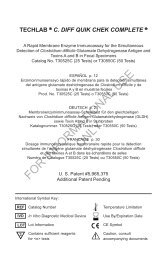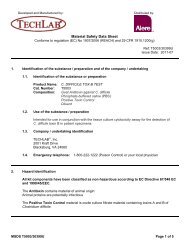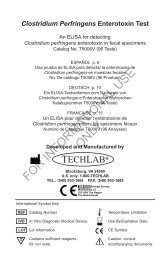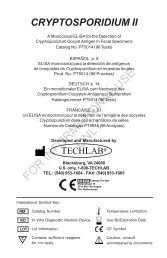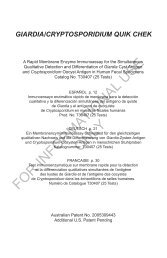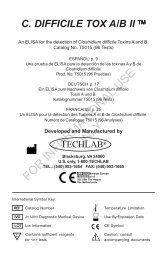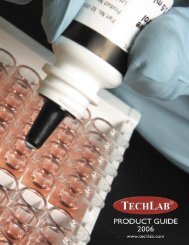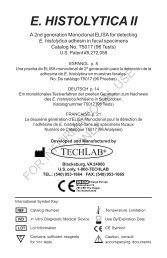ASCA-CHEK - TechLab
ASCA-CHEK - TechLab
ASCA-CHEK - TechLab
Create successful ePaper yourself
Turn your PDF publications into a flip-book with our unique Google optimized e-Paper software.
Clostridium sordellii<br />
Clostridium sporogenes<br />
Enterobacter cloacae<br />
Escherichia coli EIEC SD67<br />
Staphylococcus aureus<br />
Staphylococcus epidermidis<br />
Streptococcus faecalis<br />
Peptostreptococcus anaerobius<br />
9<br />
INTERFERING SUBSTANCES FOR SERUM<br />
Potential interfering substances present in serum were tested in the <strong>ASCA</strong>-<strong>CHEK</strong><br />
test. Each substance was tested for potential interference with <strong>ASCA</strong>-positive and<br />
<strong>ASCA</strong>-negative serum specimens. No interference was observed in the serum<br />
specimens tested. Table 5 shows the concentrations and methods of measurement for<br />
each substance tested.<br />
Table 5. Interfering substances tested in the <strong>ASCA</strong>-<strong>CHEK</strong> test.<br />
Test Substance Method of analysis Serum Concentration<br />
Lipase Hitachi 917 > 20 U/L<br />
Cholesterol Olympus AU5000 504 mg/dL<br />
Hemolyzed blood Visual red color Hemolyzed<br />
Rheumatoid Factor (RF) Nephelometry 27.9 IU/mL<br />
Antinuclear Antibodies (ANA) Nephelometry 0.263 (ratio)<br />
Bilirubin F (free) Beckman LX20 19 mg/dL<br />
Bilirubin C (conjugated) Beckman LX20 18 mg/dL<br />
INCIDENCE OF SERUM <strong>ASCA</strong> IN NON-CROHN’S DISEASE GROUPS<br />
Sera from non-Crohn’s disease groups were tested in the <strong>ASCA</strong>-<strong>CHEK</strong> test and<br />
showed a positivity range of 4% to 13%. Table 6 shows the individual disease groups<br />
with the corresponding percent positive rate. Serum <strong>ASCA</strong> may also be detected in<br />
patients with other autoimmune disorders (10).<br />
Table 6. Incidence of serum <strong>ASCA</strong> in Non-Crohn’s disease groups.<br />
Non-Crohn’s Disease Group Number Tested Number Positive Percent Positive<br />
Ulcerative colitis 46 6 13%<br />
Irritable Bowel Syndrome 30 3 10%<br />
Constipation 1 0 0%<br />
Esophagitis 1 0 0%<br />
H. pylori 1 0 0%<br />
Alcoholic Cirrhosis 20 1 5%<br />
ANA-positive 3 0 0%<br />
Healthy 94 4 4%<br />
FOR INFORMATIONAL USE<br />
ONLY<br />
REPRODUCIBILITY AND PRECISION<br />
The inter-assay variation for fecal specimens was determined using 8 <strong>ASCA</strong>positive<br />
and 4 <strong>ASCA</strong>-negative fecal specimens tested three times over a 6-day period.<br />
During the testing period all positive samples remained positive and all negative samples<br />
remained negative. The intra-assay variation was determined using 18 fecal specimens,<br />
13 <strong>ASCA</strong>-positive and 5 <strong>ASCA</strong>-negative, tested in 8 replicates for each specimen<br />
for a single test run. During the testing period all positive samples remained positive<br />
and all negative samples remained negative.<br />
The inter-assay variation for serum specimens was determined using 4 <strong>ASCA</strong>positive<br />
and 4 <strong>ASCA</strong>-negative serum specimens tested eight times over a 2-day period.<br />
During the testing period all positive samples remained positive and all negative samples<br />
remained negative. The intra-assay variation for serum was determined using 4 <strong>ASCA</strong>positive<br />
and 4 <strong>ASCA</strong>-negative serum specimens, tested in 8 replicates for each<br />
specimen for a single test run. During the testing period all positive samples remained<br />
positive and all negative samples remained negative.



